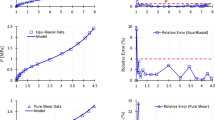Abstract
The aim of this paper is to show that it is possible to develop a fully internally consistent model for an isotropic elastic body that has nonlinear response relations but with small strains, if one chooses to begin from a Gibbs potential (or complementary energy) rather than the classical Helmholtz potential (or strain energy). We demonstrate the practical applicability of such a model and also compare the results of exact solutions (internal pressurization of a circular cylinder and the bending of a rectangular block) for incompressible materials undergoing finite deformations with corresponding exact solutions based on small deformations. Surprisingly, the results show quite remarkable agreement up to maximum strains of nearly 20–30 %. Given that most applications of nonlinear elastic materials are in this range, the results have broad implications for the ability to consistently use small deformation nonlinear theories for a wide class of applications than hitherto considered. We also show that the nonlinear compatibility equations play a key role in determining the applicability of this approach. In particular, we show that for 3-D bodies whose dimensions are of comparable orders of magnitude (i.e., excluding rod-like or shell-like bodies), the finite deformation compatibility condition ensures that small strains and strain gradients imply small relative rotations and hence small deformations. For thin bodies (rods, plates and shells), it is well-known result that small strains do not lead to small deformations due to the possibility of large rotation gradients thus leading to other possible approximations.
Similar content being viewed by others
References
Bharatha S., Levinson M.: On physically nonlinear elasticity. J. Elast. 7(3), 287–304 (1977)
Bridges, C., Rajagopal, K.R.: Implicit constitutive models with a thermodynamic basis: a study of stress concentration. Zeitschrift für angewandte Mathematik und Physik (2014). doi:10.1007/s00033-014-0398-5
Casey J., Naghdi P.M.: Physically nonlinear and related approximate theories of elasticity, and their invariance properties. Arch. Ration. Mech. Anal. 88(1), 59–82 (1985)
Criscione J.C., Rajagopal K.R.: On the modeling of the non-linear response of soft elastic bodies. Int. J. Non-linear Mech. 56, 20–24 (2013)
Criscione J.C., Humphrey J.D., Douglas A.S., Hunter W.C.: An invariant basis for natural strain which yields orthogonal stress response terms in isotropic hyperelasticity. J. Mech. Phys. Solids 48(12), 2445–2465 (2000)
Freed, A.D., Liao, J., Einstein, D.R.: A membrane model from implicit elasticity theory: application to visceral pleura. Biomech. Model. Mechanobiol. (2013). doi:10.1007/s10237-013-0542-8
Freed A.D., Einstein D.R.: An implicit elastic theory for lung parenchyma. Int. J. Eng. Sci. 62, 31–47 (2013)
Kuramoto S., Furuta T., Hwang J., Nishino K., Saito T.: Elastic properties of gum metal. Mater. Sci. Eng. A 442(1), 454–457 (2006)
Ma J., Karaman I., Maier H.J., Chumlyakov Y.I.: Superelastic cycling and room temperature recovery of Ti74Nb26 shape memory alloy. Acta Materialia 58(6), 2216–2224 (2010)
Marra S.P., Kennedy F.E., Kinkaid J.N., Fillinger M.F.: Elastic and rupture properties of porcine aortic tissue measured using inflation testing. Cardiovasc. Eng. 6(4), 123–131 (2006)
Naghdi P.M., Vongsarnpigoon L.: A theory of shells with small strain accompanied by moderate rotation. Arch. Ration. Mech. Anal. 83(3), 245–283 (1983)
Nayak G.C., Zienkiewicz O.C.: Convenient form of stress invariants for plasticity. Proc. Am. Soc. Civil Eng. 98, 949–53 (1972)
Ortiz A., Bustamante R., Rajagopal K.R.: A numerical study of a plate with a hole for a new class of elastic bodies. Acta Mechanica 223(9), 1971–1981 (2012)
Rajagopal K.R.: The elasticity of elasticity. Zeitschrift für angewandte Mathematik und 58(2), 309–317 (2007)
Rajagopal, K.R.: On the nonlinear elastic response of bodies in the small strain range. Acta Mechanica 225(6), 1545–1553 (2014)
Rajagopal K.R., Srinivasa A.R.: On the response of non-dissipative solids. Proc. R. Soc. A: Math. Phys. Eng. Sci. 463(2078), 357–367 (2007)
Rajagopal K.R., Srinivasa A.R.: On a class of non-dissipative materials that are not hyperelastic. Proc. R. Soc. A: Math. Phys. Eng. Sci. 465(2102), 493–500 (2009)
Rajagopal K.R., Walton J.R.: Modeling fracture in the context of a strain-limiting theory of elasticity: a single anti-plane shear crack. Int. J. Fract. 169(1), 39–48 (2011)
Rajagopal K.R.: On implicit constitutive theories. Appl. Math. 48(4), 279–319 (2003)
Shield R.T.: The rotation associated with large strains. SIAM J. Appl. Math. 25(3), 483–491 (1973)
Srinivasa A.R.: On the use of the upper triangular (or QR) decomposition for developing constitutive equations for green-elastic materials. Int. J. Eng. Sci. 60, 1–12 (2012)
Srinivasa, A.R., Reddy, J.N.: A model for a constrained, finitely deforming, elastic solid with rotation gradient dependent strain energy, and its specialization to von Kármán plates and beams. J. Mech. Phys. Solids 61(3), 873–885 (2013)
Author information
Authors and Affiliations
Corresponding author
Rights and permissions
About this article
Cite this article
Srinivasa, A.R. On a class of Gibbs potential-based nonlinear elastic models with small strains. Acta Mech 226, 571–583 (2015). https://doi.org/10.1007/s00707-014-1178-1
Received:
Revised:
Published:
Issue Date:
DOI: https://doi.org/10.1007/s00707-014-1178-1




